A Nice Way to Launch a New Year!
Don’t you love how a new year inspires improvement in all areas of life? And it’s a time to consider new ways of doing things and new tools to do them.
One tool you might consider (if you’re not already using it) is Castile soap. It’s been around since the late 1800s and originated in the Castile region of Spain. It’s completely different from the traditional soap most of us use.
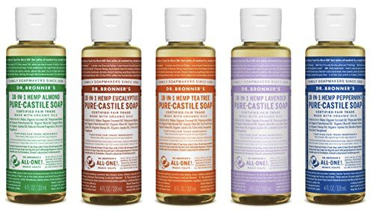
Instead of being made from animal fat, castile soap is made from simple plant oils mixed with lye. It can come in a solid or liquid form and is basically a vegan product that is a gentle disinfectant, but not antibacterial. (A disinfectant removes bacteria but doesn’t necessarily KILL all of them.)
“Hmmm…why would I want a soap that doesn’t kill ALL the bacteria?” you ask. Because antibacterial soaps contain triclosan and hexachorophene. Boatloads of research shows these chemicals are hormone disrupters and they increase the risk of generating drug-resistant bacteria. I’ll spare all the scientific blah-blah and simply say this stuff, after repeated exposure to it, has been found to be absolutely harmful to humans. So much so that on September 2, 2016, the FDA banned them and 17 other additives commonly found in over-the-counter antibacterial soaps.
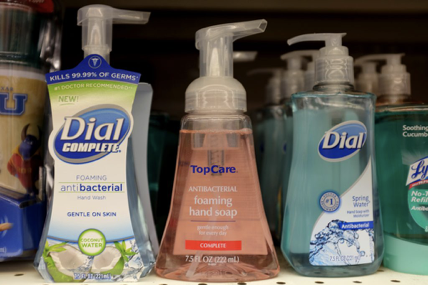
Castile soap, on the other hand, is non-toxic and a perfectly safe alternative to today’s antibacterial soaps. It has minimal impact on the environment, is safe for sensitive skin (when diluted properly), and is probably the most versatile cleaning product around. Notice, too, that it’s less expensive than the high end Meyers Clean Day products that are basically fancy Castile soap!
And it’s easy to experiment until you find a ratio that suits your personal preference. Just know that when you dilute the soap, you’re shortening its shelf life, so be sure to use the solution within a few weeks. Take a look at all ways to use a bottle of Castile soap:
FRUIT AND VEGETABLE RINSE. Forget those expensive veggie rinses. Castile soap is a great way to remove pesticides or residue from fresh fruits and vegetables. Add 1/4 teaspoon of soap to a bowl of water. Soak and then gently rub the produce using your hands. Then rinse with plain water.
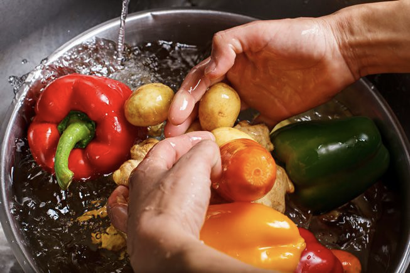
DISH SOAP. Add 1 part of Castile soap to 10 parts of water to make liquid dish soap.
DISHWASHER DETERGENT. This natural option works well as a replacement of your usual dishwasher detergent. Mix equal parts of Castile soap and water in a bottle. Fill your detergent compartment as normal.
HAND SOAP. Whether used at the kitchen or bathroom sink, this is an excellent alternative to that chemical-loaded antibacterial soap most of us use. Just add 2 tablespoons of Castile soap to 12 ounces of water. It’s optional to add 1/2 teaspoon of a carrier oil (coconut, olive, argan, almond) or any essential oil.
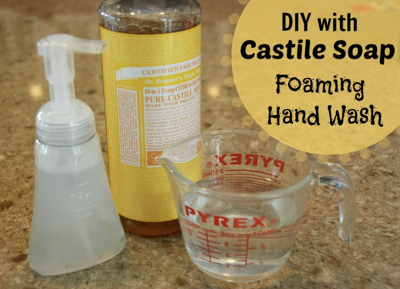
ALL-PURPOSE HOUSEHOLD CLEANER. It can tackle all sorts of cleaning jobs. Use 1 to 2 cups of soap in a quart of water as a cleaning spray.
WINDOW CLEANER. Use 1 tablespoon of Castile soap in a quart of water to clean your windows. Rinse using soda water; dry and shine the glass with newspaper.
FLOOR CLEANER. Castile soap leaves floors sparkling. Add 1/2 cup of soap to 3 gallons of hot water and mop as usual.
LAUNDRY DETERGENT. Add ½ to ¾ cup of Castile soap to a load of laundry. You can use less soap if you’re using a high-efficiency washing machine. This may be a particularly appealing option for those who get rashes from traditional store-bought laundry detergents.
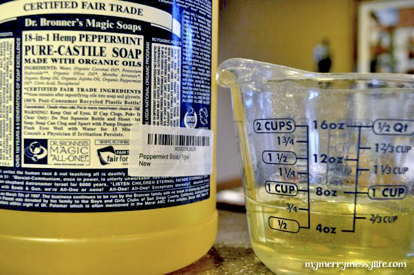
SCOURING. When used along with baking soda, kitchen and bathroom surfaces come clean quickly and without doing any damage to fine finishes. Mix 1 cup of Castile soap and 3 cups of water in a spray bottle. Cover the area to be cleaned with a shake of baking soda and then spray the cleaning solution over it. Use a sponge or brush to scrub away dirt or grime.
TOILET CLEANER. It’s a superb product for frequent toilet cleaning. While it doesn’t have the powerful (and toxic) chemicals meant for removing stubborn stains and mineral buildup (like CLR and Lime-Away) inside the bowl, it’s perfect for regular maintenance. Mix 1 cup of soap and 4 cups of water and put in a spray bottle. Use this solution to clean your toilet.
ANT KILLER. Gentle on humans yet tough on bugs! Add 1/4 cup of soap to a quart of water to make a spray that can be used to keep ants away.
PLANT PROTECTOR. Keep bugs off of your plants by mixing 1 tablespoon of castile soap in a quart of water to make a spray.
PET WASH. The exact amount of soap needed depends on the amount of hair and the size of your animal.

This marvelous soap is also good for personal care. For instance:
I’ll close with a couple things to avoid when using Castile soap. Don’t combine it with vinegar or lemon juice. The alkaline nature of the soap will react to the acid and leave behind a white film. And don’t use it on color-treated hair as it may strip away some of the color.One tool you might consider (if you’re not already using it) is Castile soap. It’s been around since the late 1800s and originated in the Castile region of Spain. It’s completely different from the traditional soap most of us use.

Instead of being made from animal fat, castile soap is made from simple plant oils mixed with lye. It can come in a solid or liquid form and is basically a vegan product that is a gentle disinfectant, but not antibacterial. (A disinfectant removes bacteria but doesn’t necessarily KILL all of them.)
“Hmmm…why would I want a soap that doesn’t kill ALL the bacteria?” you ask. Because antibacterial soaps contain triclosan and hexachorophene. Boatloads of research shows these chemicals are hormone disrupters and they increase the risk of generating drug-resistant bacteria. I’ll spare all the scientific blah-blah and simply say this stuff, after repeated exposure to it, has been found to be absolutely harmful to humans. So much so that on September 2, 2016, the FDA banned them and 17 other additives commonly found in over-the-counter antibacterial soaps.

Castile soap, on the other hand, is non-toxic and a perfectly safe alternative to today’s antibacterial soaps. It has minimal impact on the environment, is safe for sensitive skin (when diluted properly), and is probably the most versatile cleaning product around. Notice, too, that it’s less expensive than the high end Meyers Clean Day products that are basically fancy Castile soap!
And it’s easy to experiment until you find a ratio that suits your personal preference. Just know that when you dilute the soap, you’re shortening its shelf life, so be sure to use the solution within a few weeks. Take a look at all ways to use a bottle of Castile soap:
FRUIT AND VEGETABLE RINSE. Forget those expensive veggie rinses. Castile soap is a great way to remove pesticides or residue from fresh fruits and vegetables. Add 1/4 teaspoon of soap to a bowl of water. Soak and then gently rub the produce using your hands. Then rinse with plain water.

DISH SOAP. Add 1 part of Castile soap to 10 parts of water to make liquid dish soap.
DISHWASHER DETERGENT. This natural option works well as a replacement of your usual dishwasher detergent. Mix equal parts of Castile soap and water in a bottle. Fill your detergent compartment as normal.
HAND SOAP. Whether used at the kitchen or bathroom sink, this is an excellent alternative to that chemical-loaded antibacterial soap most of us use. Just add 2 tablespoons of Castile soap to 12 ounces of water. It’s optional to add 1/2 teaspoon of a carrier oil (coconut, olive, argan, almond) or any essential oil.

ALL-PURPOSE HOUSEHOLD CLEANER. It can tackle all sorts of cleaning jobs. Use 1 to 2 cups of soap in a quart of water as a cleaning spray.
WINDOW CLEANER. Use 1 tablespoon of Castile soap in a quart of water to clean your windows. Rinse using soda water; dry and shine the glass with newspaper.
FLOOR CLEANER. Castile soap leaves floors sparkling. Add 1/2 cup of soap to 3 gallons of hot water and mop as usual.
LAUNDRY DETERGENT. Add ½ to ¾ cup of Castile soap to a load of laundry. You can use less soap if you’re using a high-efficiency washing machine. This may be a particularly appealing option for those who get rashes from traditional store-bought laundry detergents.

SCOURING. When used along with baking soda, kitchen and bathroom surfaces come clean quickly and without doing any damage to fine finishes. Mix 1 cup of Castile soap and 3 cups of water in a spray bottle. Cover the area to be cleaned with a shake of baking soda and then spray the cleaning solution over it. Use a sponge or brush to scrub away dirt or grime.
TOILET CLEANER. It’s a superb product for frequent toilet cleaning. While it doesn’t have the powerful (and toxic) chemicals meant for removing stubborn stains and mineral buildup (like CLR and Lime-Away) inside the bowl, it’s perfect for regular maintenance. Mix 1 cup of soap and 4 cups of water and put in a spray bottle. Use this solution to clean your toilet.
ANT KILLER. Gentle on humans yet tough on bugs! Add 1/4 cup of soap to a quart of water to make a spray that can be used to keep ants away.
PLANT PROTECTOR. Keep bugs off of your plants by mixing 1 tablespoon of castile soap in a quart of water to make a spray.
PET WASH. The exact amount of soap needed depends on the amount of hair and the size of your animal.

This marvelous soap is also good for personal care. For instance:
- In wound cleaning
- As a deodorant (mix 1/2 teaspoon soap, 1 teaspoon sea salt, and water to fill a small spray bottle)
- As a shampoo (mix 1 tablespoon soap with 1 cup water)
- As a facial cleanser and body wash; just a few drops is all that’s needed
- As a makeup remover (mix equal parts soap, witch hazel and a carrier oil together; use with cotton ball; finish with a warm water rinse)
- As a weekly makeup brush cleaner (soak rinsed brushes in warm water with a few drops of soap; rinse well again and allow to air dry)
But those two issues aside, you can see that this is an excellent product to consider using. Non-toxic, gentle, versatile, and easy on the planet. That’s a nice way to launch a new year!
Sources:
- www.countryliving.com
- www.pbs.org
- www.mnn.com
- www.domesticserenity.org
- www.mymerrymessylife.com
- www.pinterest.com
 Alice Osborne
Alice Osborne
DVO Newsletter Contributor since 2006
Email the author! alice@dvo.com
